The appeal of street food is well known amongst travelers. When you are in a new place, you feel like eating something local people would eat. In many countries, this means street food.
Street food is affordable, tasty and easy to eat no matter where. There is something charming about it, almost as if the setting intensifies the flavors. Quite often, the same thing doesn’t taste the same at a restaurant.
We invited a group of travel bloggers to share with us all, delicious street food dishes and snacks from around the world. Click the links to their blogs to allow your senses to go on a deeper voyage of the senses…
This is Street Food worth traveling for:
Mexico: Tacos al Pastor
If you’re heading to Mexico, forget everything you’ve ever known about the “tacos” anywhere else, which are typically smothered in cheese, sour cream and shredded lettuce. Forget all of that. Street food tacos in Mexico have an unparalleled complexity, using very few toppings and ingredients.
My favorite street food dish is the tacos al pastor (fire grilled pork deliciousness), shaved right off the spit and onto fresh corn soft tortillas. The pork is marinated in chilies and pineapple and cooked slowly on a spit-style grill. You can ask for cheese if you want, but I preferred them without to allow the flavor of the pastor to come through. Even street side, tacos are served with a salsa verde (green tomato salsa), fresh cilantro, diced red onions, and hot red salsa.
Not into tacos? You can also order pastor meat in a burro (burrito) or on a torta (Mexican sandwich). Whichever way you choose, anything with pastor is bound to be an incredibly delicious and cheap street-side meal in Mexico!
By Katie Lutz of From Shores To Skylines
Vietnam: Banh Mi
Just recently, the BBC wondered whether it was the world’s best sandwich and Vanity Fair shared Marcus Samuelsson’s recipe (Spoiler! It includes bourbon and Madeira, as you do). It seems like the whole world is in love with the humble banh mi (baguette sandwich), one of Vietnam’s most ubiquitous street foods available 24/7 on street corners up and down the country.
Thanks to a hundred years of French colonization, the Vietnamese make crunchy, buttery baguettes daily and mobile glass carts found everywhere are ready to fill them with fried eggs for breakfast and a host of meats for anytime eating, including roast pork (both char-siu and crispy styles); meatballs; shredded pork skin; canned sardines; cold cuts; and the list goes on and on. The baguette will usually get a smear of butter and pâté to start off with, then a layer of meat(s), some cucumber, coriander sprigs and occasionally a bit of spring onion. Pickled carrots and radishes provide a nice tartness, as does a few slices of fresh chilies for heat and a finishing splash of soy sauce as a seasoning.
Get them at actual bakeries for a fresh-from-the-oven, soul-satisfying meal that’s less than a dollar.
By James Pham of Fly Icarus Fly
Myanmar: Pork Hot Pot (Wat Thar Dote Htoe)
Wat Thar Dote Htoe literally means “Pork on a stick” and this is the most popular street food amongst the locals in Myanmar (Burma).
These are prepared and served at a hot pot stall on the street with small chairs around it where you can sit and pick your favourite sticks. There are sticks around the hot pot with every cut of pork you can think of including its intestines, ear, tongue, and more, which they love dipping in a chili sauce. If you love pork and aren’t afraid to try new things, this is the stall for you.
Myanmar borders Laos, Thailand, China, Bangladesh and India and has been strongly influenced by its powerful neighbors, not only in culture, art and religion, but also in cuisine. If Asian food is one of the best and most varied in the world, imagine a country with its own delicious cuisine plus a healthy dose of Asian ingredients and cooking styles!
By Juan Gallardo of Myanmar Travel Essentials
Iran: Ashe Mast (Yoghurt Soup)
With hospitality being so important to Iranians, I found that during my travels through Iran buying street food usually turned into an invitation to an elaborate meal at someone’s house. At the very least I would be invited into the kitchen to warm up by the stove with a cup of tea and bowl of pistachio nuts. But for the few occasions where I did manage to sit down for a quick bite at a street side vendor, I had one go-to dish: ashe mast, or yoghurt soup.
The soup is an Iranian favorite and comes in many different varieties – hot or cold, with or without meat, a thin soup or thick stew – but I particularly loved the vegetarian version. It’s usually served with Barbari flatbread, making for an incredibly cozy and filling meal. My mouth is watering just thinking about it!
By Silvia Lawrence of Heart My Backpack
Belgium: Waffles
We were in Ghent, Belgium when we finally succeeded in finding some typical Belgian street food that was also vegan. It was not an easy task and quite challenging, hence the happiness we both felt when we dug into a delicious and crunchy Belgian waffle we bought from a food truck during Ghent Festival.
There are many controversies about the waffles not being originally Belgian, but they are still largely sold in the streets and bars everywhere in Belgium. Apparently the difference with the American waffles is that the Belgian ones are bigger, made with a not very heavy batter, and with deeper pockets that can hold more sauces, fruits, ice cream or whatever you wish to have with it.
The vegan version we had was very nice indeed, crunchy enough but not too much, keeping the softness in the middle. We decided to have it plain to taste the actual waffle and we were highly satisfied with it. If you are in Belgium looking to try some street food different from the well known Belgian fries and you have a sweet tooth like us, look out for waffles and go crazy with the toppings too.
By Franca of AngloItalian FollowUs
Madagascar: Mofu Anana (moo-fu ah-na-na)
Throughout Madagascar, simple stove top breads — called mofo (moo-fu) — are the one of the most ubiquitous and well loved local street snacks. From round semi-sweet breakfast breads (mofo-gasy), to more savory breads mixed with vegetables, Madagascar has got a “mofo” for any time of the day.
Mofo anana, which literally translates to “leafy greens bread” is a simple fried bread made from batter mixed with (surprise, surprise!) chopped up leafy greens and tomatoes. The batter is then deep fried in vegetable oil over a charcoal stove and the little doughy treats are churned out by the dozen.
Usually served with sakay (hot sauce), these savory dough balls make for a filling and delicious snack between meals — especially when you catch them fresh out of the pan!
Look out for regional variations like “mofo liasoa” (cabbage bread) as well, and keep your nose peeled around late afternoon when most city’s vendors come to life preparing a fresh batch of snacks on street corners, in bars, and marketplaces.
By Jessie of The Nomadic Beat
India: Gol Gappa
Gol Gappa aka Pani puri (watery bread) is one of my favourite Indian street snacks. It’s not just yummy on the tongue, but it’s also lots of fun the way it is eaten. It’s a crispy round puri filled usually with chickpeas, potatoes, chutney and flavoured water. Since it’s as little as your mouth, you have to have it all together. The most amazing part is the blend of sweet-spicy flavours in your mouth and the clatter of the crispy puri as you chew it. Later after you have finished eating, you can enjoy some more flavoured water.
Interestingly, Gol Gappas are mostly devoured by women in India! There is an uncanny association of perky Indian women with this tangy street snack. You will usually find a bunch of women lined up at the Gol Gappa stall waiting for their turns to have their favourite snack one after the other.
It wouldn’t be wrong to say that it’s a snack that tickles happiness.
By Renuka of Voyager For Life
Malaysia: Durian
As a shameless foodie, sometimes I am asked what my favourite food is, or what I would want my last dinner to be. My answer is always the same: durian.
I tried the King of Fruits for the first time from a street stall in Penang, Malaysia, and I was hooked forever. People’s relationship with durian is a love/hate kind of affair, and most Westerners usually fall in the ‘hate’ category.
Durian is sweet and custard-flavored, with a wonderfully creamy texture. Trouble is, it has a rather pungent smell, compared by some to that of a ‘septic tank’ or ‘rotten pig spleen’. But if you can get past its peculiar scent, chances are you’ll love it like I do.
Around Malaysia, you’ll find various types of durian products, from durian chips to durian candies, from durian cakes to durian ice-cream. But nothing beats buying durian from a street stall, watching the seller open it with a bog knife before sharing it with friends.
The best durian varieties come from Penang, the capital of Malaysia when it comes to hawker dishes. The best of the best come from the area near the Air Itam dam in Penang, where several durian varieties are for sale, especially during durian season (June-July). Go hungry and you won’t regret it!
By Margherita of The Crowded Planet
Tanzania: Mishkaki
Popular as both a snack and a full feast, Tanzanian mishkaki are skewers of meat, marinated in a combination of spices, garlic, and ginger, grilled over fire, and served with onions and pili pili sauce (chili sauce).
Mishkaki is especially popular along the east coast of Tanzania, in Dar Es Salaam, and throughout its islands, like Zanzibar and Mafia Island – the area of Tanzania that’s been influenced by both Middle Eastern and Indian cuisine. There’s often a choice of either beef or chicken mishkaki, both of which are extremely tasty. You can either eat mishkaki on its own, or accompanied by a plate of chips (fries).
When you’re in Tanzania, and see smoke pouring from a make-shift grill on the side of the road, order some fresh skewers of mishkaki, and you’ll be extremely happy.
By Mark Wiens of Migrationology
Puerto Rico: Pastelillos
A typical Puerto Rican snack you will find at any road side kiosk, festival, street stall and often in small bars is the Pastelillo.
Similar to the Empanada although the pastry is lighter and flakier, Pastelillos come with all sorts of fillings including ground beef, seafood and chicken. Some of the best Pastelillos we have had are filled with lobster or conch meat, the filling cooked with a sauce similar to creole.
You will find similar snacks throughout the Caribbean by many different names but the Puerto Ricans will staunchly defend theirs as being specific to Puerto Rico and of course the best. Most Puerto Ricans can tell you their mother or aunt has a secret recipe that will out do any other.
People will often enjoy a Pastelillo as a beer snack, we recently lived on an island off the coast of Puerto Rico for 6 months and would often stop for Pastelillo de Carrucho (conch) and a cold beer on our way home from the beach. They are so good, we had to restrict ourselves to one a week – Buen Provecho!
By Kate of Vagrants of the World
Cambodia: Pong Tea Khon (Balut) – Fertilized Duck Embryo
Pong tea khon is better known by its other name – Balut. But it doesn’t matter where you go, it is essentially the same thing: A fertilised duck embryo. In some places it is considered a delicacy, but in Cambodia it is a standard dish you can find in many street food stalls.
Costing anywhere from 25 cents to $2, depending on where you go and your bartering skills, this is not a cuisine for the queasy-stomached. Cracking open the shell you are confronted with the foetus of a baby duck, head and all. The trick is to break it up into smaller pieces and apply a liberal dose of freshly squeezed lemon, salt and pepper and just jump straight in. Crunching down on the head and breaking up the beak is a strange experience; especially with the locals staring down at you. But this is not a tourist-only affair. The Khmer people love it, but never consume more than one a day. Some people even believe it can increase male fertility.
Pong tea khon can be found just about anywhere, and trying one is definitely for the adventurous food tasters.
By Lesh and Jazza of NOMADasaurus
Slovakia: Langoš
Langoš [laan-goh-sh] is Central Europe’s answer to pizza—flat bread with sauce and toppings. Originally a Hungarian specialty, langoš is the most popular street snack in Slovakia (variations of it also exist in the Czech Republic, Serbia, Croatia and Romania).
You can find langoš in places where people want an easy and delicious snack—train stations, festivals, busy intersections, even bus stops. The flat bread, which is very similar to Native American fry bread, is the highlight of langoš: lightly fried, crispy and chewy, it can be pulled apart or folded and eaten like a taco. In Slovakia, garlic, ketchup, cheese, and tartar sauce are the typical condiments, though some places also offer ‘novelty’ toppings like sour cream and chocolate. A good langoš arrives on an oil-soaked square of butcher paper, and it has a strong garlic underpinning that’s nicely offset by the sweetness of the ketchup and creamy tang of the tartar sauce.
Langoš goes very well with Slovak cola-style beverage Kofola or with beer such as Šariš.
By Peter Korchnak & Lindsay Sauve of Where Is Your Toothbrush?
Sweden: Cinnamon Rolls
One of the most classic Swedish street foods is Cinnamon Rolls. Believe it or not, cinnamon rolls were invented in Sweden, which is why they are original and delicious. Also known as Kanebullar in Swedish, these delicious rolls have a robust, sweet flavor that will keep you coming back for seconds.
The Swedes take so much pride in their cinnamon rolls, that there is a National Cinnamon Roll Day in Sweden on October 4. During this day, all cafes, restaurants and street food vendors cook their tastiest rolls to provide to hungry citizens. How amazing is that?
But if you’re not in Sweden on Oct. 4, then you can find cinnamon rolls from many street vendors, as well as small local bakeries around the country. It would be a crime to visit Sweden and not eat a cinnamon roll!
By Drew of The Hungry Partier
Romania: Mititei
Tasty food has always been a part of the Romanian culture. Almost anywhere you eat the food is delicious and street food is no exception.
One of my favorite street foods in Romania is the famous Mititei – a hand-formed ground meat roll grilled over charcoal. The Romanian word mititei (also known as mici) means “small ones”, or “wee ones”. Mititei are not an exclusive Romanian recipe, but rather one specific to the Balkan Peninsula. However, the mixture of meats and condiments used in their preparation is different from region to region. The Romanian Mici are prepared from equal amounts of ground lamb, beef and pork, seasoned with garlic, black pepper and hot pepper.
The story has it that one evening a popular mid-19th-century inn in Bucharest was out of lamb intestines used for stuffing the sausages. Since the customers were requesting them, the chef formed the unstuffed meat mixture into sausage-shaped cylinders and grilled them over charcoal. The customers, delighted by the new recipe, called them mititei or “the wee ones.”
They are served with hot mustard and bread and generally accompanied by beer. In summer time the smell of hot mititei on the grill fills the air of Bucharest, luring passerby.
By Anda Galffy of Travel Notes & Beyond
Turkey: Balık Ekmek
In the heart of Istanbul by Galata Bridge are the famous floating fish boats that have achieved international fame for their humble but delicious sandwiches. Centuries ago, local fishermen installed grills on their Ottoman style boats so they could supply busy city workers with fresh food to go.
The concept has since become a tourist attraction and these days hundreds of locals and foreign visitors queue for fish enclosed between crusty bread and accompanied with lettuce, tomato and onion.
This simple but delicious sandwich costs a mere 5 lira (2.50 USD) and many Turkey travel experts list it as a recommended activity while in the bustling metropolis. To complement the sandwich with a drink, you should order traditional Ayran (yogurt, water and salt) or Pomegranate juice.
If you have no plans to visit Istanbul, Balık Ekmek is sold all over Turkey and is particularly favoured from October onwards, when the hamsi (anchovies) season starts but Turks will always say the best fish sandwiches are from the floating fish boats of Istanbul.
By Natalie Sayin of Turkish Travel Blog
Honduras: Baleada
Baleadas are the most common street food in Honduras. They can be eaten any time of the day but are typically eaten for breakfast or lunch. The foundation of any baleada is a big, fluffy, handmade flour tortilla. The tortilla is then filled with refried beans and crumbled cheese. There are many different varieties and depending on the restaurant, you might have your choice of adding meat, butter, tomato, egg, lettuce and avocado.
Similar to a burrito, you eat them with your hands which makes them a great grab and go snack. They are served from roadside vendors and restaurants for about a dollar or two each.
By Amanda of Adventure Junkies
Poland: Pierogi
This was my number one thing to try when in Poland and I wasn’t disappointed. You get pierogi (Polish dumpling) in many ways. The wet version is more like filled pasta not much different to giant ravioli. And the dry version is a fried pastry-like pie also packed with your choice of filling.
The wet potato ones you find in the Old Town Square were my favourite, but the kids were fans of the meat filled ones. Only Josh was a fan of the mushroom and cabbage variety.
For sweet options we enjoyed the fried versions the best, with the apple and cinnamon flavoured pierogis made it off the plate in record timing.
In the Old Town Square you can get 5 for 5 zloty (AUD$1.74, €1.20).
By Erin from Travel With Bender
The Philippines: Puso (hanging Rice)
Puso or Hanging Rice is a popular street food in the Visayas Island, Philippines.
Puso is derived from a Visayan term referring to bunga or flower while in Tagalog dialect Puso means Heart. This rice wrapped and boiled in a heart shaped palm leaves is normally sold in some restaurants and mobile food-cart vendors in Cebu and other parts of Visayas and Mindanao Island. Puso is eaten like steamed rice and generally paired with a savory dish.
By Melo from Out of Town Blog
Laos: Khao Jee
Khao jee, or a French style baguette is the kind of food that might surprise you when travelling in Asia. It breaks all the stereotypes about Asia as a “rice & noodles” country and the reason lies in the country’s history, when Laos used to be a part of French Colonial Empire in Southeast Asia.
You’ll find Khao jee in a stall in bigger streets in Laos, a typical breakfast served with filtered coffee, but sold also throughout the day as a brunch, lunch or light dinner. That said, there are plenty of ingredients you can choose from, as well as different dips and sauces.
Nowadays there is a westernised upgrade of the baguette and you can easily find one filled with a peanut butter or Nutella and banana. You’ll pay from $1.20 to $2.50 for a baguette, depending whether you go for sweet, vegetarian or the meatier option.
Khao jee is still one of the most popular street foods in Laos, although we are not sure whether you can call it ‘local street food’, since we have never seen a Laotian queuing for a sandwich.
By Ivana & Gianni of Nomad is Beautiful
Guatemala: Rellenitos de Platano
Guatemala, like most of Central America, borrows much of its gastronomy from indigenous cultures, European settlers and neighboring countries, which explains the vibrant diversity of dishes found on any Guatemalan street.
Rellenitos de Plátano, also called Rellenitos Guatemaltecos, are one of the street food mainstays in Guatemala, becoming ubiquitous whenever there is a celebration or a busy market in the vicinities. They are basically plump ripe plantains, mashed and stuffed with a black bean paste, which depending on the region and recipe will be either thick or softly runny. Although considered a dessert (or, to many Guatemalans, one of those grandmotherly treats we all love), usually displayed next to a traditional Pepián de Pollo or Subanik, the Rellenitos are quite filling and are a fantastic pick-me-up at any time of day. They can be eaten cold or warm, and are normally sprinkled with sugar on top. In fancier places, cream is also added.
We find them utterly delicious (particularly when they also add a hint of cinnamon to the mashed plantain) and recommend them to anyone visiting the glorious landscapes of Guatemala.
By FW & Elle of Lunaguava
China: 煎饼 (Jiān Bĭng)
Chinese street food varies immensely from province to province, and even city to city (that’s why I’m writing a whole book on the subject), so it’s something of a fool’s errand to select a single street food to represent the entire country. But, if pressed, I would give my vote to 煎饼 (Jiān Bĭng) as the quintessential Chinese street food.
There is some dispute about where jiān bĭng originated (probably either Beijing or Tianjin), although it’s sort of a moot point since nowadays you are likely to stumble across it in any Chinese city. Like many great street foods, jiān bĭng is fairly simple: a gloppy batter of wheat flour, soy flour, egg, and water is spread onto a round griddle to be fried like a crepe. While it cooks, the vendor cracks a fresh egg or two atop the pancake, scatters a handful of green onions, and smears some chili sauce (spicy) and fermented bean sauce (sour) across the whole shebang. On top of all that, the vendor will add either a crispy cracker called báo cuì (in Beijing) or a long, greasy Chinese cruller called yóu tiáo (in Tianjin’s variation). Once finished cooking, the vendor rolls it up, folds it in half, and you eat it like a breakfast burrito. A completed jiān bĭng is eggy, spicy, salty, sour, heavy, rich, and oily—just what the doctor ordered.
China may be home to more interesting, more adventurous, or possibly even tastier street foods, but none typify the essence of Chinese street food quite as wholly as jiān bĭng.
By Frank Kasell of A Field Guide to Chinese Street Food
Czech Republic: Sausages
Prague is a great place for cheap street eats. And nowhere else is better than Wenceslas Square – anytime you go there is a sausage fest going on. On every corner of the street you’ll see crowds milling around sausage stands. For 40 kc to 60 Kc (between 2-3 USD) you can get your choice of sausage; the white Bavarian sausages, the Nuremberg Sausage, and local variants such as the Wenceslas sausage, the Prague sausage, and the Old Prague sausage (I don’t think too much thought was used making up those names). My favorite was the Prague sausage – it’s redder and spicier than the other sausages. Smack some hot mustard and sauerkraut in the bun and it’s ready to go.
Vegetarian? A consistent (and only) veggie option at these sausage stands is Fried Cheese.
We were in Prague 3 months this summer and fell in love with the city. Sausages, accompanied by a beer, were part of the reason
By Frank of The Travels of BBQ Boy and Spanky
Egypt: Om Ali
Afraid of eating “street food” but at the same time want to try the local cuisine in Cairo? Then Gad Fast-Food chain in your next meal destination in Cairo. Clean, cheap and lovely food. The menu features a variety of chicken, fish and meat dishes, and European dishes as well. You can try some Egyptian classics such as tame, filter, foul, or fatuous served with pita bread.
But what it’s a must is the dessert: the Om Ali.
Legend has it that Om Ali was the first wife of the sultan Ezz El Din Aybek. When the sultan died, his second wife had a dispute with Om Ali, resulting in the second wife’s death. To celebrate, Om Ali made this dessert and distributed it among the people of the land.
Sweet, with a lot of syrup, it literally melts in your month. It comes in 6 slices, but I barely could eat 4!
By Sorin of Kiki Journey
Cuba: Pizza
When it comes to street food, Cuba definitely has it covered! Cuban street food is famous among locals and travelers alike, not only for its abundance and availability, but also for its ridiculously cheap prices. And while it may not be the traditional Caribbean food you think of, you can’t go past the pizza if you’re searching for delicious street food in Cuba. And the best part; this mouthwateringly cheesy delight will fill your stomach and also leave you plenty of money to spend on rum.
Everywhere you go in Cuba you’ll find the smell of pizza wafting through the streets. Vendors operate out of their houses, opening up their double front windows and literally serve it straight out of their living rooms. There are usually only a few varieties, all loaded up with copious amounts of cheese, but you really can’t go wrong for only 5-10 Cuban pesos (20-40 cents). Our tip; buy a plain cheese pizza for 20 cents, cut up some fresh tomato, onion and avocado to put on top, then wash down with a nice cold rum and coke.
By Jules and Christine of Don’t Forget To Move
Nepal: Momos
Said to have originated in the high altitude plateau of Tibet, the filled dumplings called Momos eventually found their way into Nepal and through local adaptations became a popular dish that nowadays can be found everywhere inside the country. Surprising for a Hindu culture, the most common ones are Buff Momos with a filling of minced water buffalo meat, but vegetarian version are usually also available. If served on a big plate in a sit-down restaurant or in a small bowl in the streets, Momos can be enjoyed at any time of the day and function either as a full blown meal or a snack on the go.
My personal favorite are the vegetable Momos that are served steaming hot on the streets of Kathmandu, either in a dried leaf with spicy sauce, or in a small bowl with soup. While walking along the small alleyways of Nepal’s capital, the big steam pots can be seen everywhere in front of little whole-in-the-wall shops, inviting all pedestrians to stop for a steaming hot bowl of fresh goodness. Trying as many different types of Momos as possible is definitely an experience that should not be missed when visiting Nepal, but tasting them ones will probably leave you craving for more anyway…
By Dennis of See The World In My Eyes
Montenegro: Cevapi
A lot of the Balkan countries have similar street food favourites, but the most popular among many of them (including Montenegro) is cevapi.
It’s a kebab dish made of grilled minced meat, typically served in a flatbread and topped with onions, sour cream, kajmak, ajvar, cottage cheese, salt, and red pepper. The meat is usually pork, or beef, but sometimes lamb is an option. If it sounds like a heavy dish, that’s because it is: it makes the perfect hangover cure after a rough night pounding back shots of rakija (and, let’s face it, it’s bound to happen while you’re travelling through Montenegro).
The best part? It’s cheap as heck! Just a few Euros for a full plate.
By Candice of Walsh of Candice Does The World
Italy: Arancini
Having backpacked through Italy three times now, the one thing we know for sure is that Italians are fiercely competitive when it comes to food. The variation in regional cuisines is so drastic that it’s almost hard to believe that you’re in the same country – and it made picking one street food to represent Italy a Herculean task. Despite this, after mulling on the topic for a while, there really was just one choice as the ultimate Italian street food – Arancini.
Coming originally from the world-famous Italian street food capital of Palermo, this Sicilian specialty has been keeping its people stuffed for more than 1000 years. At their most basic, Arancini are rice balls stuffed with local delicacies, coated in breadcrumbs, and deep-fried to golden-brown perfection. However, upon closer examination they are so much more. They are cheap, often costing no more than a couple of euro; they are portable, easily fitting in your hand; and they are filling, making for the perfect midday snack to get you through to late Italian dinner. If that wasn’t enough, they come in enough varieties to fill any craving you have – from the sweet and savoury arancini con ragù (with ragu and mozzarella) to the mild and creamy arancini con burro (with béchamel and prosciutto) to arancini con pistacchi (with pistachios) and everything in between.
Next time you’re in Italy be sure to make some time between eating pizza and pasta to try an Arancine – especially if you’re in Sicily.
By Travis Huyghebaert of Have Blog Will Travel
Korea: Tteokbokki
Korea’s street food culture is lively, brimming with a huge variety of mouthwatering eats, and so affordable.
One of the most iconic Korean street foods and my personal favorite is called Tteokbokki. The main ingredient in this dish is thick slices of chewy rice cake, which are then cooked to tender perfection in a sauce made from an extremely popular Korean red pepper paste called Gochujang. To add more flavor and variety, most all vendors will also add thin slices of fish cake, hard boiled eggs, and choice cuts of cabbage. But it doesn’t stop there! On request, you can also add deep fried seafood and crispy egg rolls. This is one street food dish that can easily be made a meal, and for ridiculously cheap too! Two portions of Tteokbokki with the fried seafood cost only 4,000 won at my favorite stand. That’s less than $4 USD for a hearty meal for two that is both filling and delicious.
Like all Korean food Tteokbokki is plentiful, overflowing with unique flavors and textures, and is wholly affordable for a traveler on the go. On top of all that, it is very uniquely Korean; you’ll probably never eat something quite like it anywhere else in the world.
By Morgan Sullivan of A Beautiful View
Samoa: Coconut
Street food isn’t really a thing in Samoa. In fact, once you leave the capital city of Apia there are not really even restaurants in Samoa. Samoa is a very self sufficient country where families keep animals and farm the main ingredients that they require for their own needs. When staying in Samoa, you will be fed by your hotel or guest house for all your meals.
I guess the closest thing to “street food” in Samoa is the good ole’ coconut. Everywhere you go, you will be handed a fresh coconut for refreshment.
For more information about the food from Samoa, check out Guide to Food in Samoa here.
By Jade Johnston of Our Oyster
Morocco: Ghoulal
Morocco is a land of spices and intriguing cuisine hidden around every corner. One of my favorite snacks that you can find in almost any city’s main square is ghoulal.
What is ghoulal you ask? Snails, of course and I love snails. A quick search on google for Moroccan snail soup and you will find many videos and photos of this traditional street snack. I had my first taste of ghoulal in Jemaa el Fna square in Marrakech. I was walking along the square when I saw a stand with a mound of snails. My mind focused in on those snails and I bee lined it to the stand. I love escargot and I am always up for trying new things. These snails were certainly not escargot; instead they are cooked in a broth filled with pepper, cumin, ginger, thyme, licorice root, mint, peppermint, tarragon, oregano, and fennel seed. I don’t know about you but I love good spices and I love these. The snails were tender little morsels that I plucked out of their shells and devoured. Ghoulal is everywhere and a street food staple in Morocco especially in the fall and winter.
Next time you visit Morocco make sure you grab a bowl of these delicious suckers.
By Alex Sexton of In Pursuit of Adventure
Venezuela: Freshly-caught seafood
When you visit the beach in Venezuela, local entrepreneurs are happy to delight you with freshly-caught seafood street food.
They catch the seafood early in the morning and neatly pack it with ice into coolers. While beachgoers enjoy their day in the sun and sea, mobile vendors come by with coolers and prepare various dishes in front of you. Some have lobster, others shrimp and calamari, and some have pre-mixed ceviche.
All are light, cool, and refreshing.
By Adam Pervez of Happiness Plunge
Grenada: BBQ
In the very southern reaches of the Caribbean, in the West Indies, you’ll find the tiny island of Grenada, which was our home for 7 months! Every Friday around 2:00pm, like clockwork, people would set up little BBQs in front of their homes, just on the side of the road. Chicken and pork were the proteins of choice and each vendor made their own special blend of tangy, flavourful BBQ sauce. The meat was always very tender and although it was messy to eat, it was the perfect dinner on Friday nights. We loved how locals, expats and tourists would all enjoy the food together.
There are so many things to do in Grenada, but experiencing a local BBQ on Friday nights is a must!
By Dariece of Goats On The Road
Japan: Takoyaki
Street food culture is quite different in Japan compared to most other Asian countries because you don’t really see food carts packing into the streets every evening. One of the best times to try Japanese street food is actually during festivals. In fact, many street food vendors travel continuously around the country, setting up at the thousands of open air events that occur across Japan annually.
One street food dish you can count on finding year-round, however, is takoyaki. It’s available in just about any Japanese city but it’s particularly popular in Osaka, a city known for its passionate foodie culture. Consisting of a piece of octopus cooked inside a crispy batter ball, takoyaki sounds exotic but the taste is surprisingly mild. You’ll typically be served six of these golf-ball-sized snacks, topped with mayonnaise, Worchester-like sauce, and fish flakes. I think it’s kind of an Osaka rite of passage to burn your mouth biting into the balls’ molten-hot center.
Watching the takoyaki being prepared is almost as entertaining as actually eating them. A veteran vendor can cook dozens of takoyaki at a time, quickly using a pick to flip the balls in a special griddle that gives the takoyaki their signature circular shape.
By Jess of Ways of Wanderers
Costa Rica: Churchill
This is a churchill, a popular treat in Costa Rica. Ticos love their sweet stuff and this dessert is essentially a sugar overload, filled with ice cream, kola syrup, powdered milk, condensed milk and biscuit rolls. They usually give you an extra cup of condensed milk in case you don’t have enough!
You can find this version in Puntarenas the city where the churchill was made famous. In other areas of the country, there is another version called the copo which you can find in any beach town. You’ll see copo vendors lined up and down the beach selling these yummy treats for just 1000 colones ($2). Instead of ice cream, the copo has shaved ice but still packs a punch with kola syrup and powdered and condensed milk. Some vendors even add fruit or a marshmallow to top it off.
During dry season when temperatures get up to 40 degrees Celsius for days on end on the coast, this little sweet treat is the perfect way to cool down.
By Yeison and Samantha of Mytanfeet
Croatia: Roadside Pork
In Croatia you’ll find all kinds of tasty treats being sold on the street. From fruit and vegetables, through to olive oils, cheeses and anything between. Although all tasty, our favourite street food has to be roasted meat. Specifically a roasted pig. Cooked in small little huts on main and small villages roads throughout Croatia you’ll find this sold by the kilo.
Meat masters begin preparing the meat at the crack of dawn, where the small of burning wood surrounds the local area. Within several hours the meat is roasted to perfection and ready for you, all you need to do is find a bakery, and buy some fresh bread to enjoy a mouth-watering lunch.
By SJ Begonja of Chasing the Donkey
Iceland: Lamb Hot Dog
Though hot dogs may usually be attributed to traditional U.S. street food, this is no traditional dog. Order yours with “the works” and it will be topped with ketchup, Icelandic sweet mustard, a remoulade made with mayo and sweet relish, raw onions and their specialty fried onions. For even more crunch, ask for extra fried onions on top like I did. You won’t regret it. Combining savory flavors from the sausage, sweetness of the mustard and remoulade, with a kick from the onions, you won’t be disappointed. This really is one of the best hot dogs you’ll ever taste.
Though widely available, the best place to order these in Reykjavik is at Bæjarins Beztu Pylsur. Translating to “the best hot dog in town”, they have a location near the harbor where they’ve been putting out these hot dogs since 1937. Though this is a must-eat for travelers, they also have a large local following.
Food can be particularly expensive in Iceland. At around $3 each, these dogs aren’t only delicious, they’re one of the best deals you’ll find in Reykjavik!
By Cameron Cobb of Cam Escapes
Portugal: Castanhas Assadas
Portugal’s street food scene is not very big at all. But when Fall comes, at least in big cities like Lisbon or Porto, roasted chestnut vendors start populating the street corners. Whole chestnuts are roasted using charcoal and seasoned with heaps of salt. Not only the nutty and earthy flavors from the charcoal tasty delicious, holding a package of castanhas as you walk the streets helps you warm up too. Traditionally, half a dozen or a dozen chestnuts would be wrapped up in cones taken out of the phone directories or yellow pages. Now-a-days, for food safety, this is not allowed, but many vendors still keep food wrapping papers with similar prints as those directories, for the sake of tradition and, I think, a little advertising too.
If you visit Portugal during the winter, you’ll come across stands of roasted chestnuts almost for sure. Often vendors shout out “quentes e boas!!” (hot and good). But even if you don’t understand them, the fumes and smells that disperse in the air will lead the way!
By Zara of Backpack ME
What’s the best street food you’ve ever had?
(feel free to link to your yummy photos in the comments!)

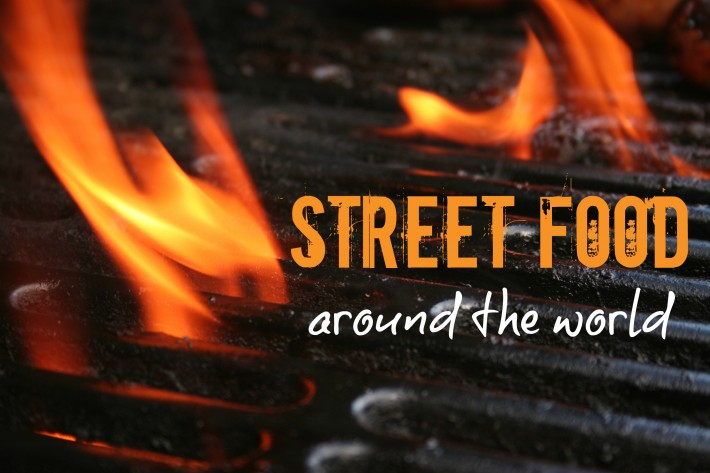
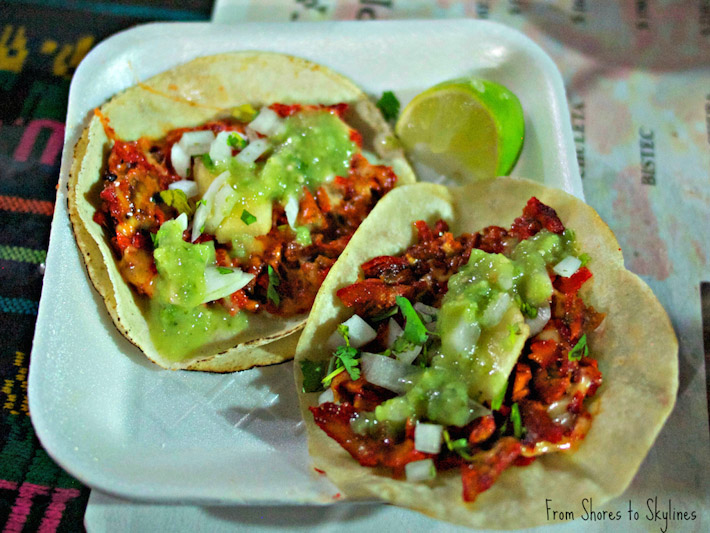
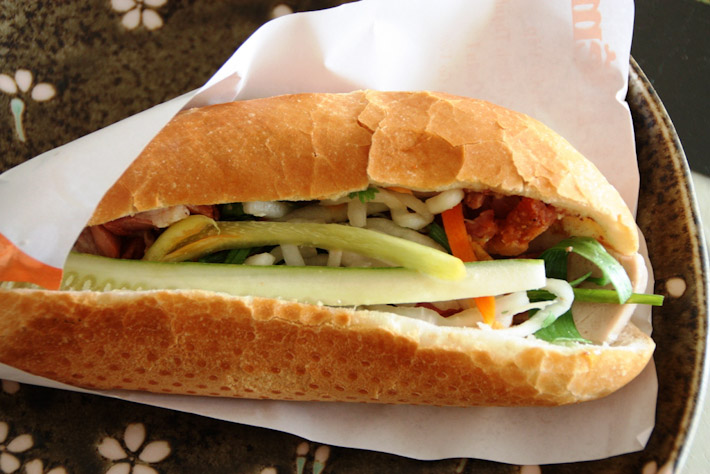
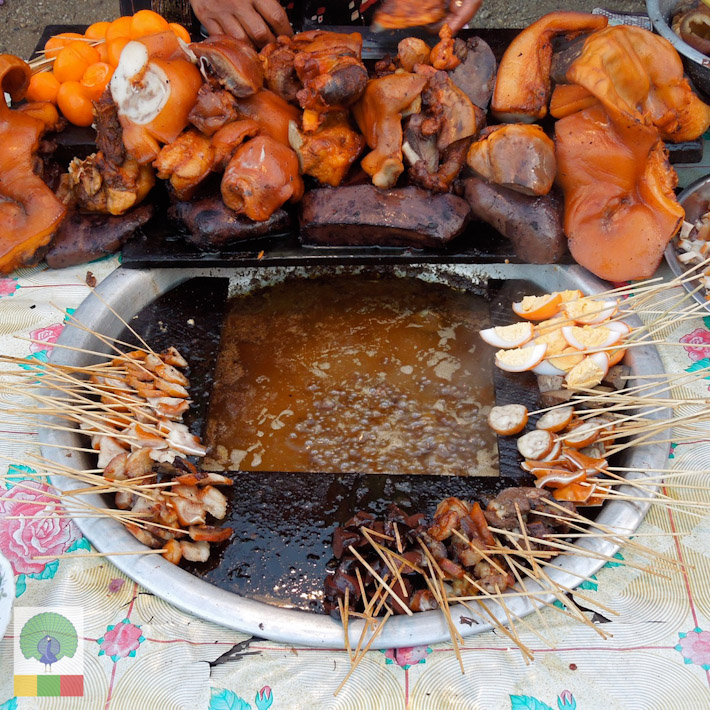
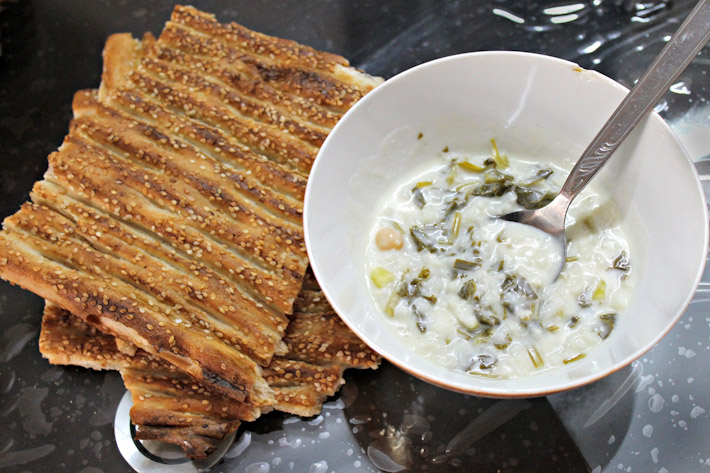
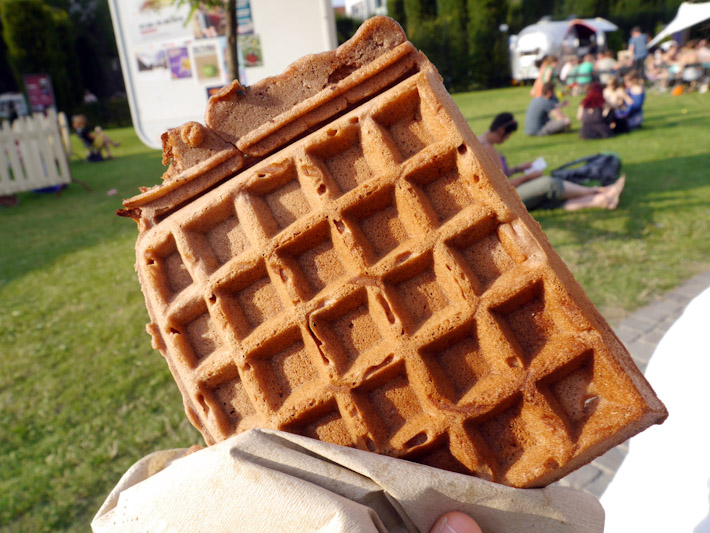
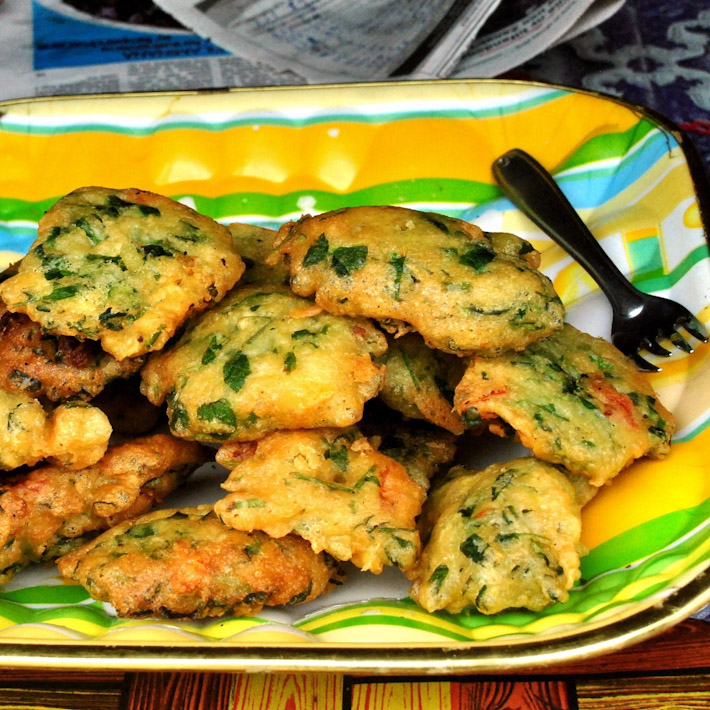
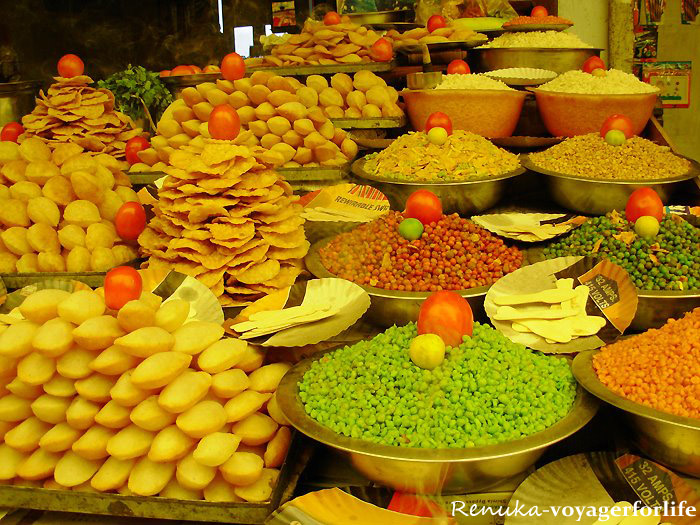
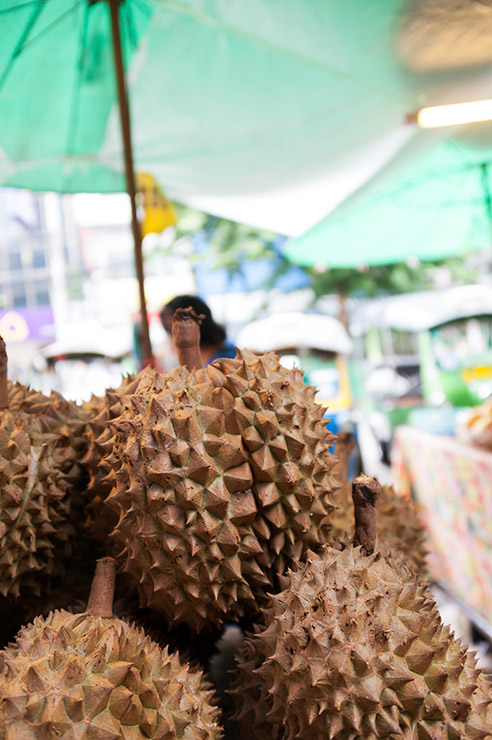
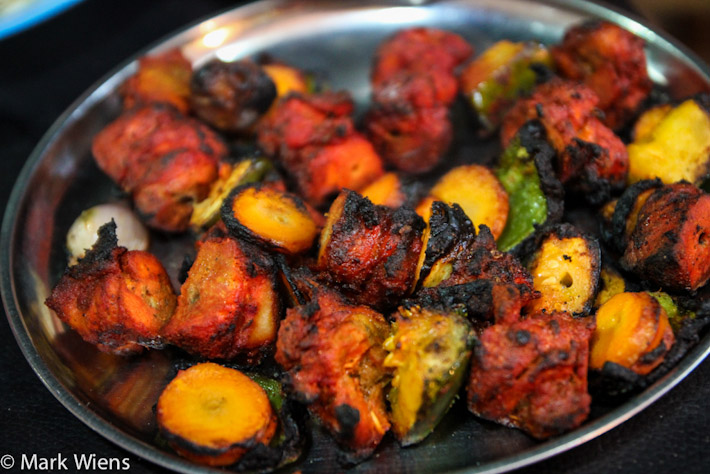
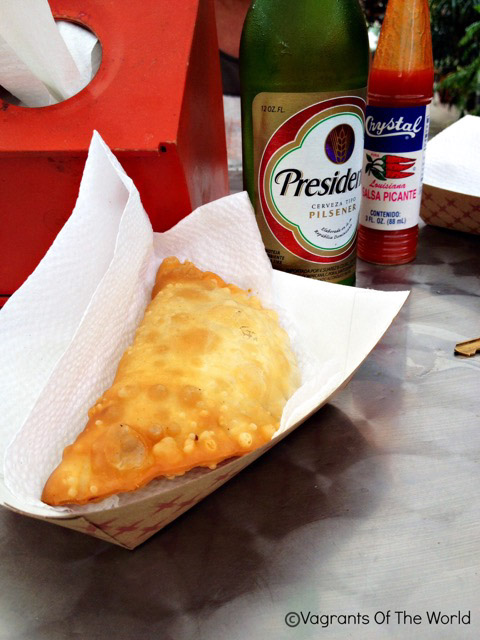
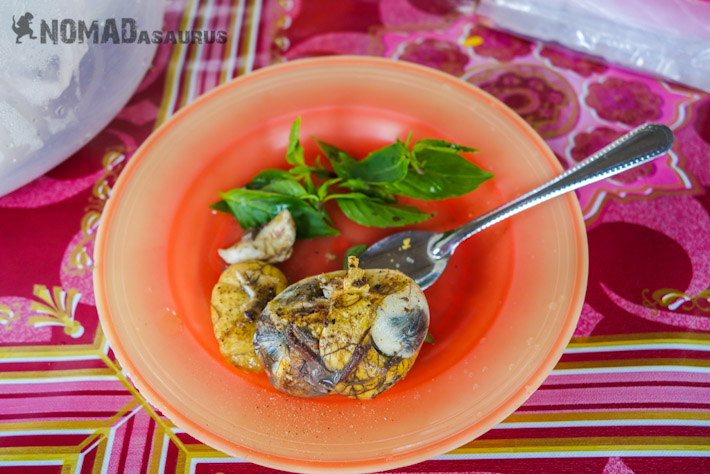
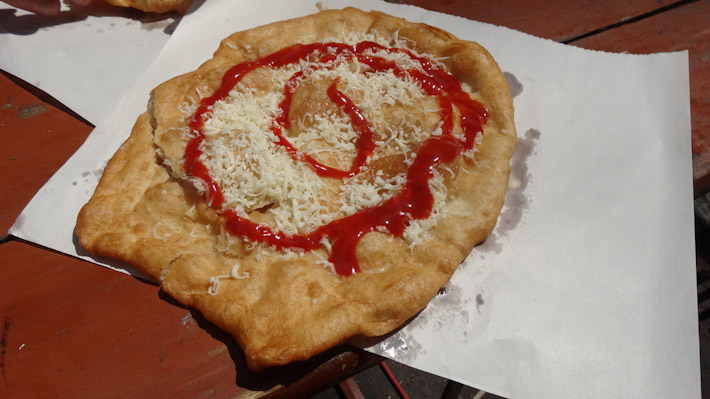

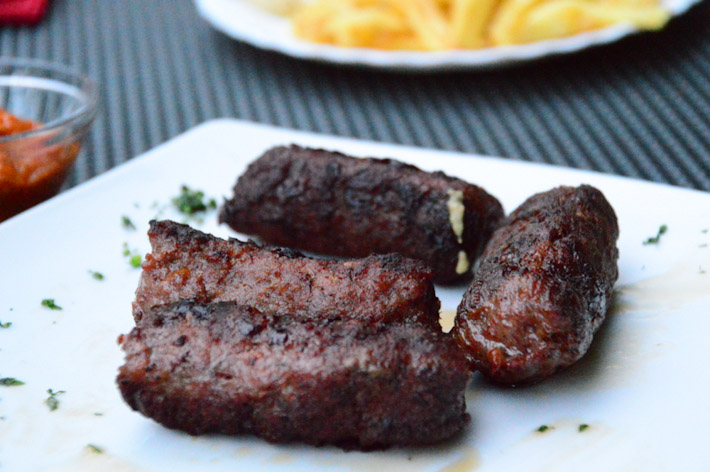
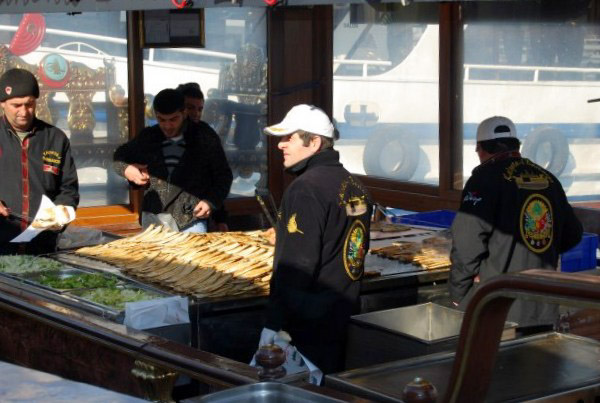
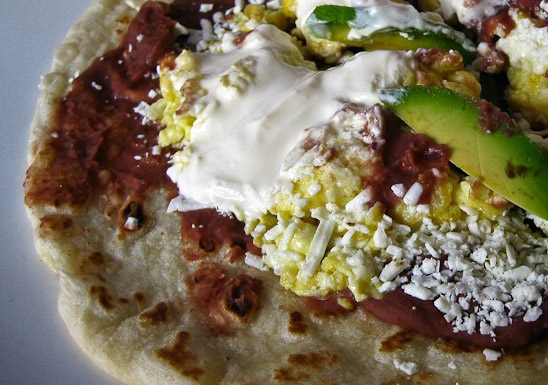
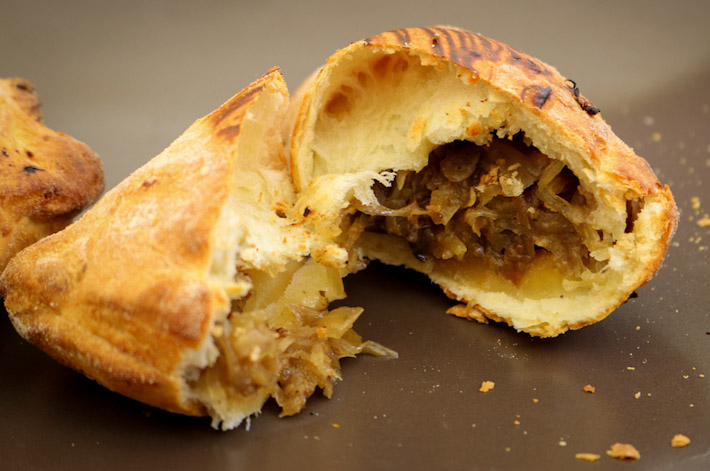
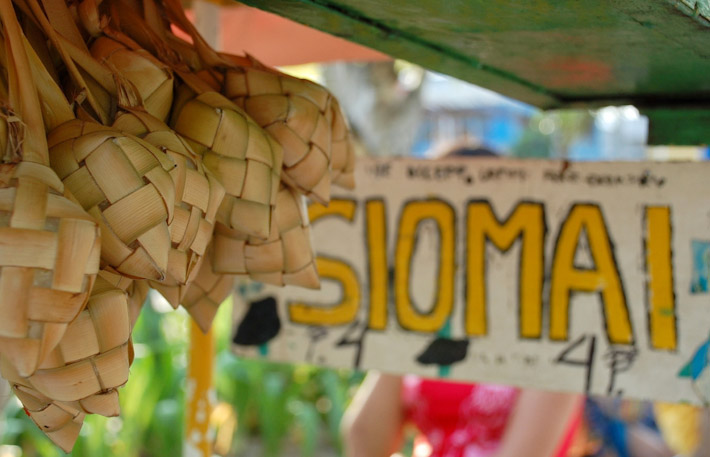
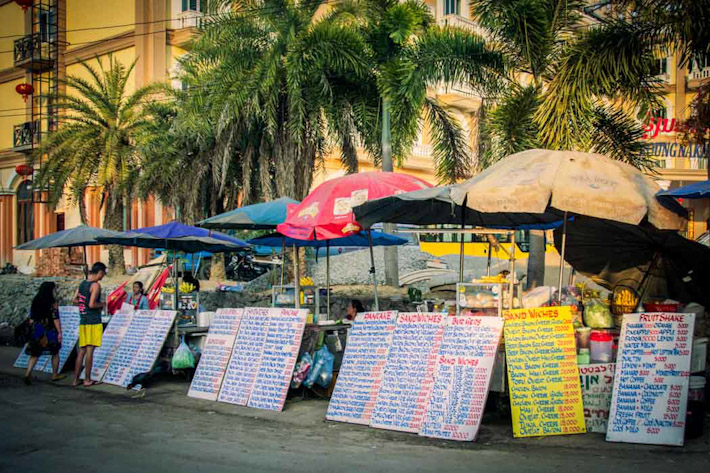
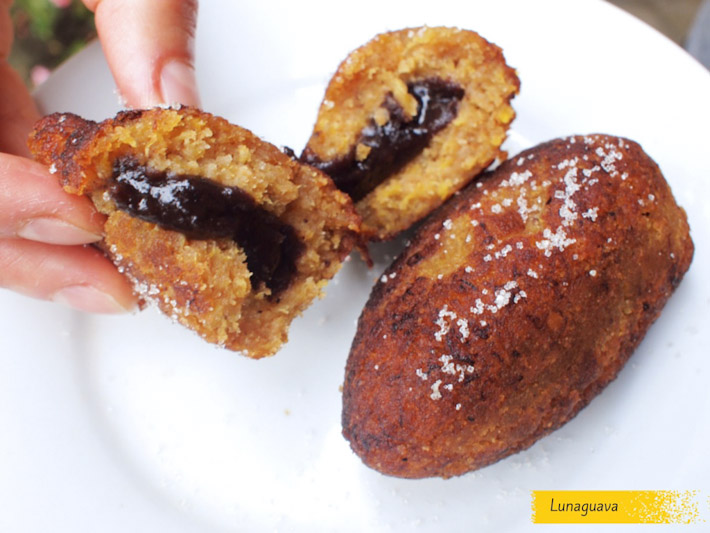
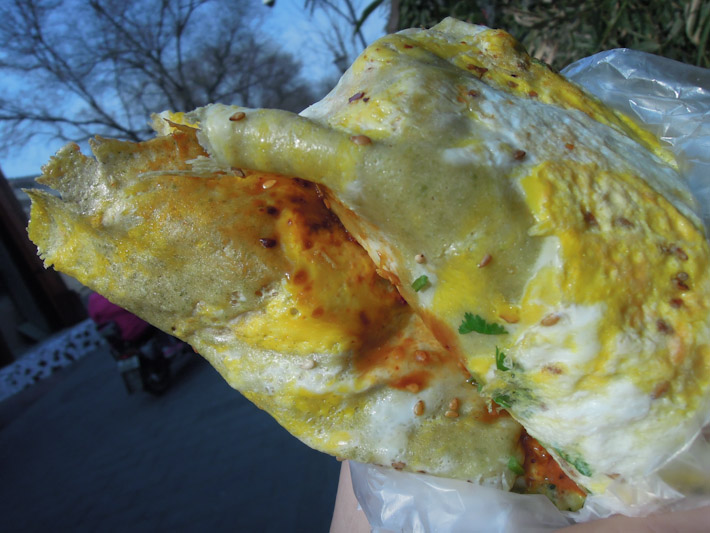
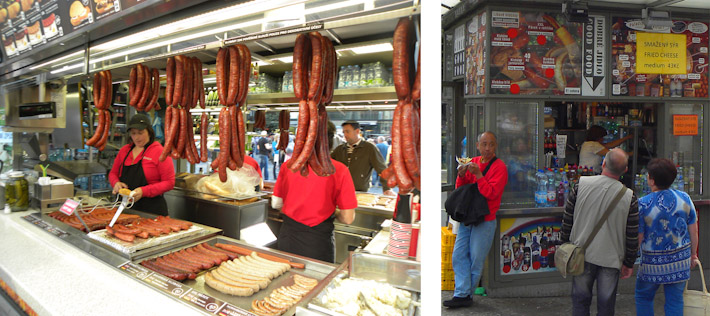
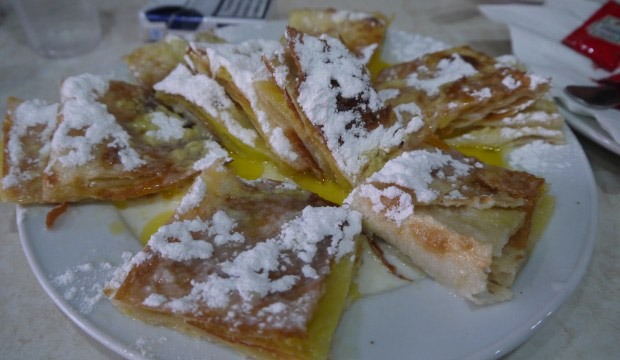

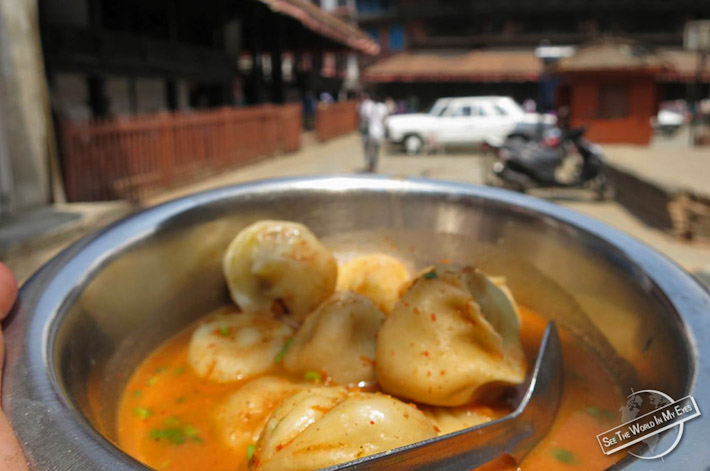

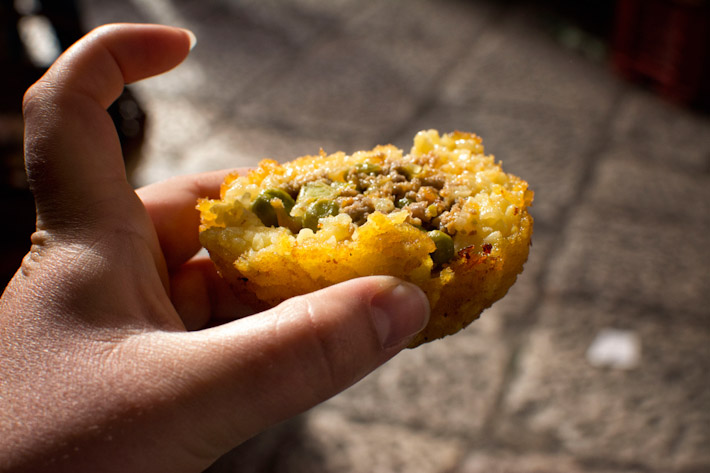
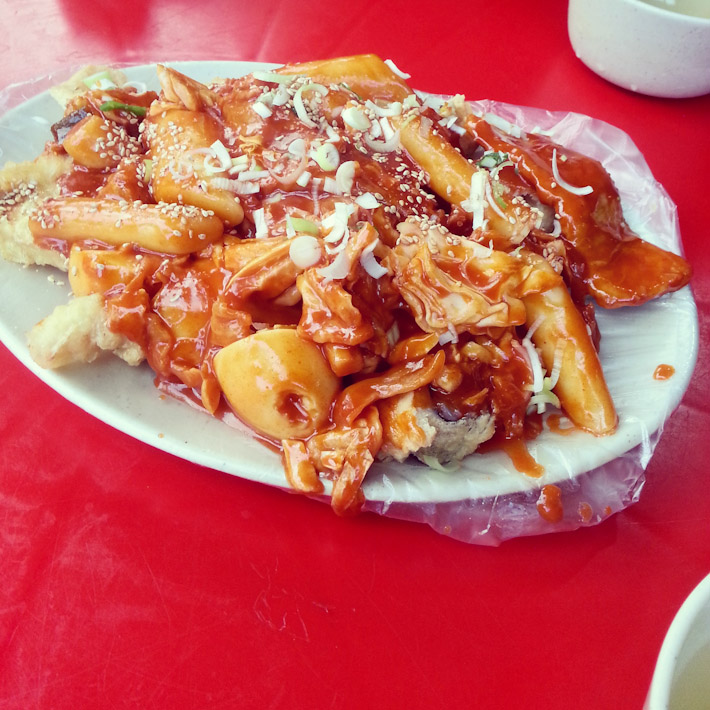
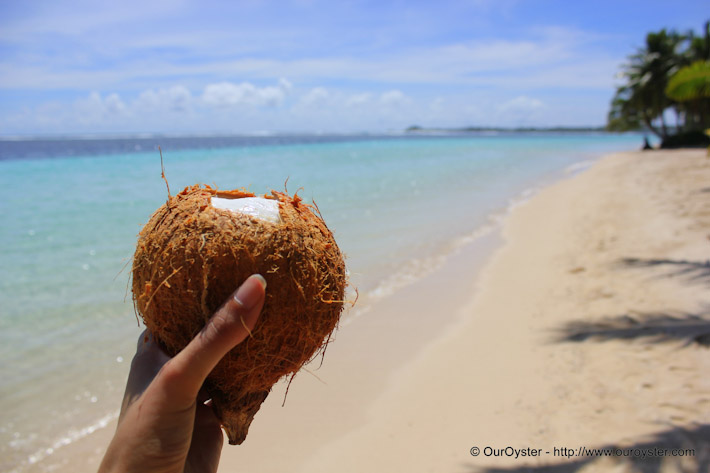
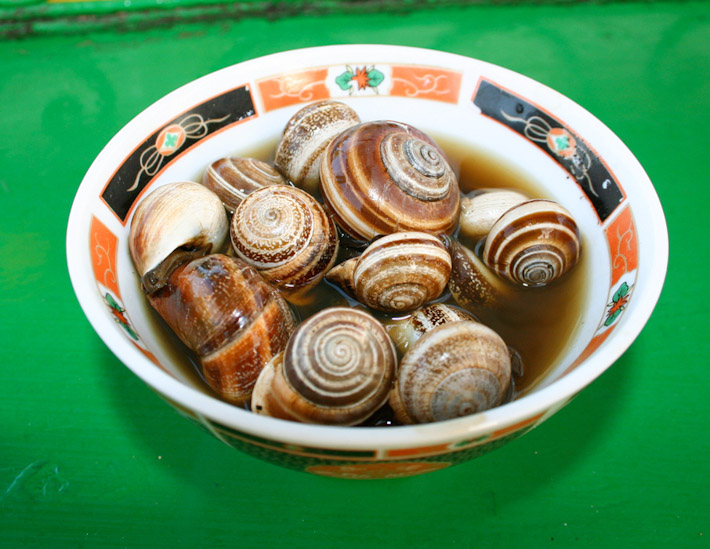
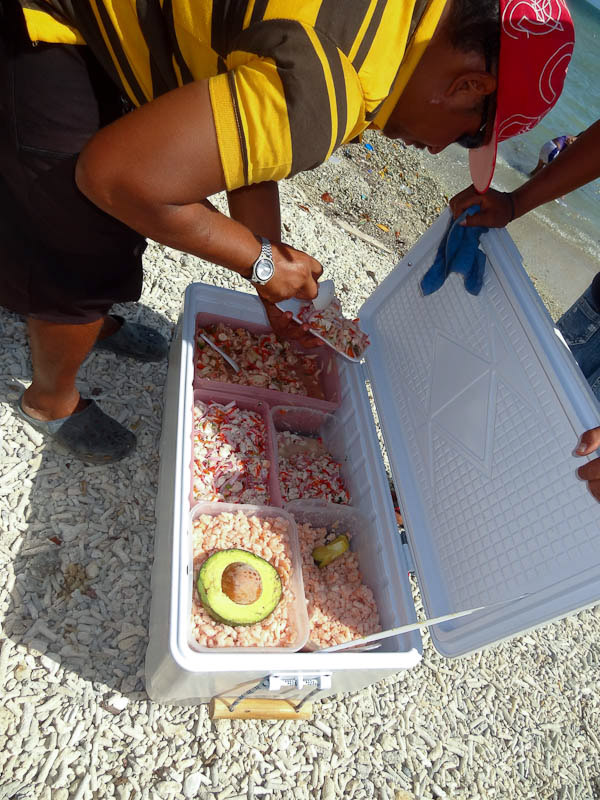
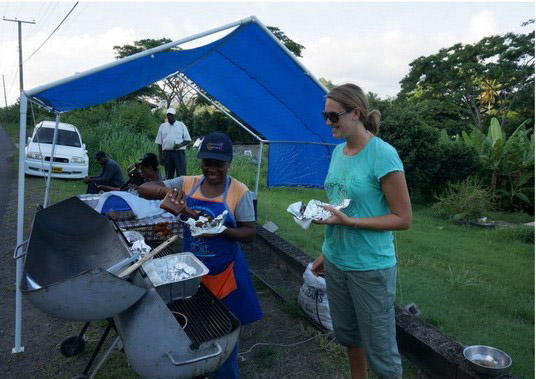


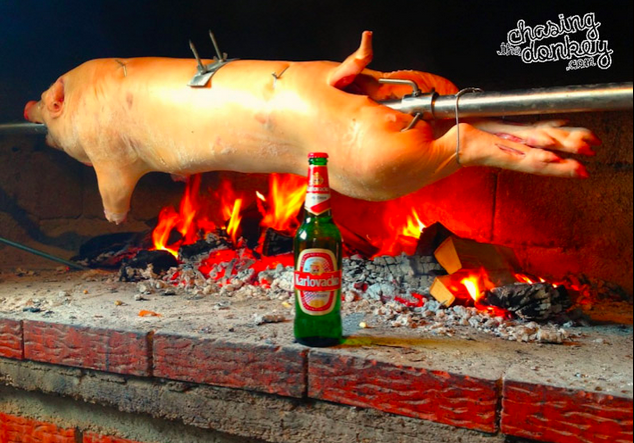

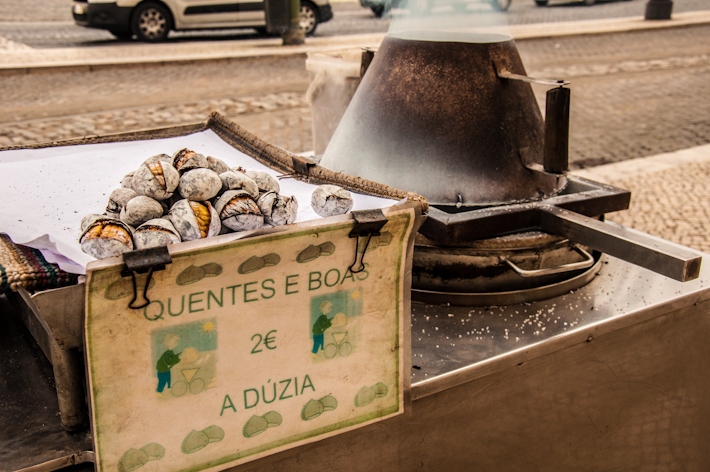
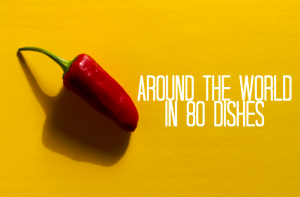

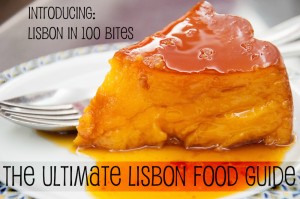
YUM! So many enticing options! Great list, guys – and many thanks for including us!
Thank you for participating!
What an epic post! The pictures made me drool. We’d add souvlakia from Cyprus to this list – pork cooked on skewers, served in pitta bread with salad and a dressing made from tahini. YUMMY.
That sounds yummy indeed! Plus, anything with tahini tastes good! ;)
Oh man, I am so hungry now reading all of these…..nom nom nom
It always happens with this type of post! ;)
Zara what a post!!! Momos and Banh Mi are my faves. We feasted on each when in Kathmandu and especially when we were in Hoi An, Vietnam. I have to give the Banh Mi the #1 spot here. We would hit those little carts, and ask for our fillings. The French influence really has a bearing on the choice of bread and the inside of the sandwich/sub is full of yummy goodness; eggs, cucumbers, etc, etc. Love em, and it’s giving me an urge to book a flight to Vietnam as I write ;)
What a list of eye candy here.
Thanks for sharing Zara!
Ryan
I’m glad you enjoyed the post, Ryan!
Thanks for reading! :)
Awesome post!!! I LOVE street food, and made the mistake of reading this right before lunch. Which will not be yummy street food! :) Thanks for including me!!
Thanks for your contribution, Katie! :)
Very very nice! You got it right for Italy, Arancini rocks! Thanks
Unfortunately I have never tried it myself.. but everybody raves about it!
I hope to travel to Italy sometime and give it a go in its original place! :)
Oh. My. Goodness. What a list!
I’ve actually had most of these and more than I’d care to admit (I once ate 100 momos in less than 24 hours while in Nepal; they were just so good!)
However, I take slight offence that durian is on the list; not my favourite fruit in the world (it’s pineapple before you ask).
Nothing beats street food.
100 momos in less than 24 hours is INSANE!! :O
Awesome post! Just one correction: pierogi in Poland are not Street food.
Thanks for pointing that out Anna!
I’m glad to see that durian made it to this list too, we absolutely loved it whilst in Thailand and Malaysia and craving for some now that we cannot find any in Europe. Thanks for including us :)
Thanks for your participation, Franca!
We haven’t tried durian yet.. never got the guts after smelling it!..
Right on! This is pretty darn definitive. Great job compiling the list. I have a bit of a sweet tooth, so I’m leaning towards the churchill as being my favorite at the moment…
We never had Churchill while in Costa Rica… I’m starting to think we missed out!
I lve to try all xstreet food. So far Vietnam was the place I found more diversity and quality. Oh man i ate baleadas in honduras like crazyyyy. As a portuguese castanhas assadas almost everyday in october, they are super delicious!
Yes, food in Vietnam is amazing!
And I am glad to see the Portuguese taste represented in this comments thread! ;)
What a great diversity of foods. I’d like to try each one of them. Thank you for sharing this post.
Thanks, Anda!
Food is a great inspiration for new adventures! :)
Yum yum yum. I love street food!
Thanks so much for this delicious post! I am so thrilled to be part of it. Now I know what to try in each country that I (hopefully) visit. ;-)
Wow Zara, that really is a long list of delicious looking street food! It actually looks like the food is getting better from one dish to the next, giving us quite some tasty reasons to check out what’s cooking along the roads in different countries…
Many thanks for having me participate in this delicious feast… :)
Pingback: Is It Wrong To Lick My Computer Monitor? - ThreadTripping
You must to come and try panamenian food.
Pingback: In Pursuit of Adventure - Exploring the world, one culture at a time.
Wow! What a great compilation A & Z! I’m adding many of these to my list as we speak. Thank you for putting this together with the collaboration of so many other great food & travel bloggers! I’ll send over a few ideas you may like as well. Cheers!
Oh wow this post has made me so hungry!
I love street food my favourite kind of street food being Thai or Indian but it looks like there is lots of others for me to try yet